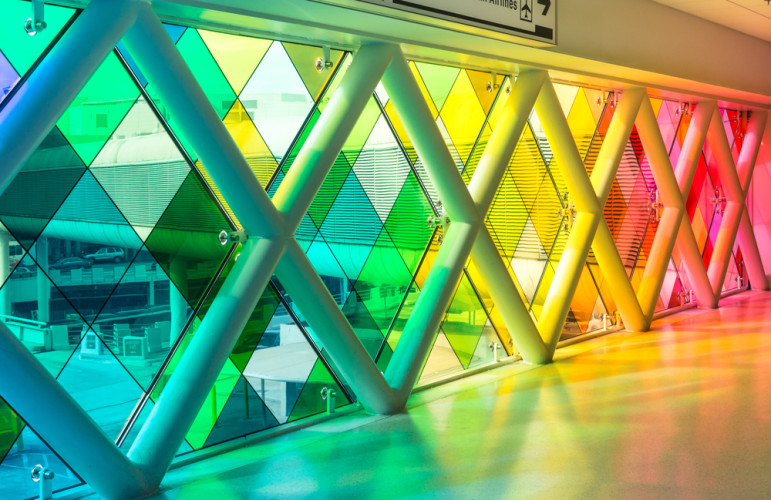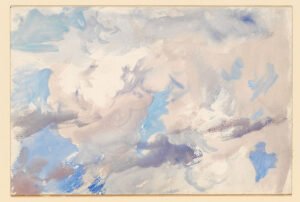
October 6, 2015; Minneapolis Star Tribune and WSPA-TV (Greenville, SC)
Over the centuries, artwork, including paintings, murals, and sculptures, has been placed in traditional places such as monarchs’ castles, houses of worship, and museums. As a result, art has often been thought of as something “out of reach” that does not easily resonate with common people. But since the 1960s, when people began to share their political views on a more widespread and larger scale, modern art also became more mainstream (for example, Andy Warhol, Roy Lichtenstein, and David Hockney), and by becoming more mainstream, art was no longer destined just for museum walls and the eyes of a select few.
Today, it’s not uncommon to encounter art exhibits when walking through airports. Many airports around the world feature art for their passengers. As part of the expansion and renovation project of the Los Angeles International Airport and in partnership with the City of Los Angeles Department of Cultural Affairs, eleven public spaces feature temporary art exhibitions. According to Miami International Airport’s website:
The primary mission of the Division of Fine Arts and Cultural Affairs is to humanize and enrich the airport environment through the commission of contemporary artwork and the presentation of exhibitions that communicate culture, environment, and art resources of an international scope with special emphasis on those areas served by Miami International Airport.
Thanks in large part to environmental sculptor Christo, parks and other public spaces have also become a common venue for art exhibits. In 2005, Christo’s The Gates stretched across 23 miles of walkway in New York’s Central Park. On display for 16 days, it attracted more than four million visitors. In a previous NPQ newswire, “A ‘Shocking’ Pink Stiletto in Utah Causes a Stir: The Purpose of Art,” art’s definition was questioned by residents of a small Utah town when a sculpture of a large pink stiletto was placed at a busy street corner.
Sign up for our free newsletters
Subscribe to NPQ's newsletters to have our top stories delivered directly to your inbox.
By signing up, you agree to our privacy policy and terms of use, and to receive messages from NPQ and our partners.
Since no single piece of art appeals to everyone, art exists both as a form of expression and as a way to generate conversation. This is why recent news from Minneapolis was music to the ears of those who work in museums or any peripheral business associated with the professional art world. With numbers of museum visitors and memberships on the decline, museums need to attract attendees, donors, and fans in creative ways. The Minnesota Vikings’ new stadium, set to open in 2016, will feature an art collection that will rival that of many museums. Tanya Dreesen, a vice president for the Minnesota Vikings, explained, “Art and sports are about drama and excitement, and the Vikings collection will reflect that.”
According to Star Tribune journalist Mary Abbe:
Stadium art is a booming trend that can broaden a venue’s appeal beyond die-hard sports fans. AT&T Stadium, home to the Dallas Cowboys, for example, has a spectacular collection of murals…[making it] a glossy setting for mega-concerts and even a 2012 simulcast of Mozart’s The Magic Flute performed by the Dallas Opera.
Sports & The Arts (SATA) is a California-based company that specializes in stadium projects. (Previous clients include New York’s Yankee Stadium and San Francisco’s Levi’s Stadium.) SATA picked artists from more than 1,100 applicants. The collection’s pieces were created by 34 Minnesota artists, ranging from nationally known talent to recent art school graduates. In fact, a piece of ceramic art about Minnesota lakes by former Vikings defensive end and Hall of Famer Carl Eller is part of the exhibition. Three themes will shape the Vikings art: Minnesota’s geography, landmarks and people, the state’s sports teams, and Vikings players past and present.
If people are unable or unwilling to visit museums or galleries but are open to viewing art where it overlaps other facets of their lives, such as airports, public spaces, and sports stadiums, then it will generate opinions and discussions, which is something that art connoisseurs everywhere hope for whenever someone views a piece of art—no matter where it may be encountered.—Debbie Laskey













